I've always loved my mom's classic chicken curry. But one weekend, while staring at our backyard mangga tree heavy with ripe carabao mangoes, I had this wild idea: what if I combined our sweet Philippine mangoes with my favorite curry?
This Mango Curry Chicken (or what my kids now call "Curry sa Mangga") has become our new family favorite! It's the perfect marriage of our local ingredients with curry flavors we Filipinos have grown to love.
The sweetness of our Philippine mangoes melts into the creamy gata, creating this incredibly rich sauce that will have you reaching for extra rice. If you love both curry and mangoes (and honestly, who doesn't?), you need to try this recipe.
It's a great way to use those extra ripe mangoes during summer season.
Jump to:
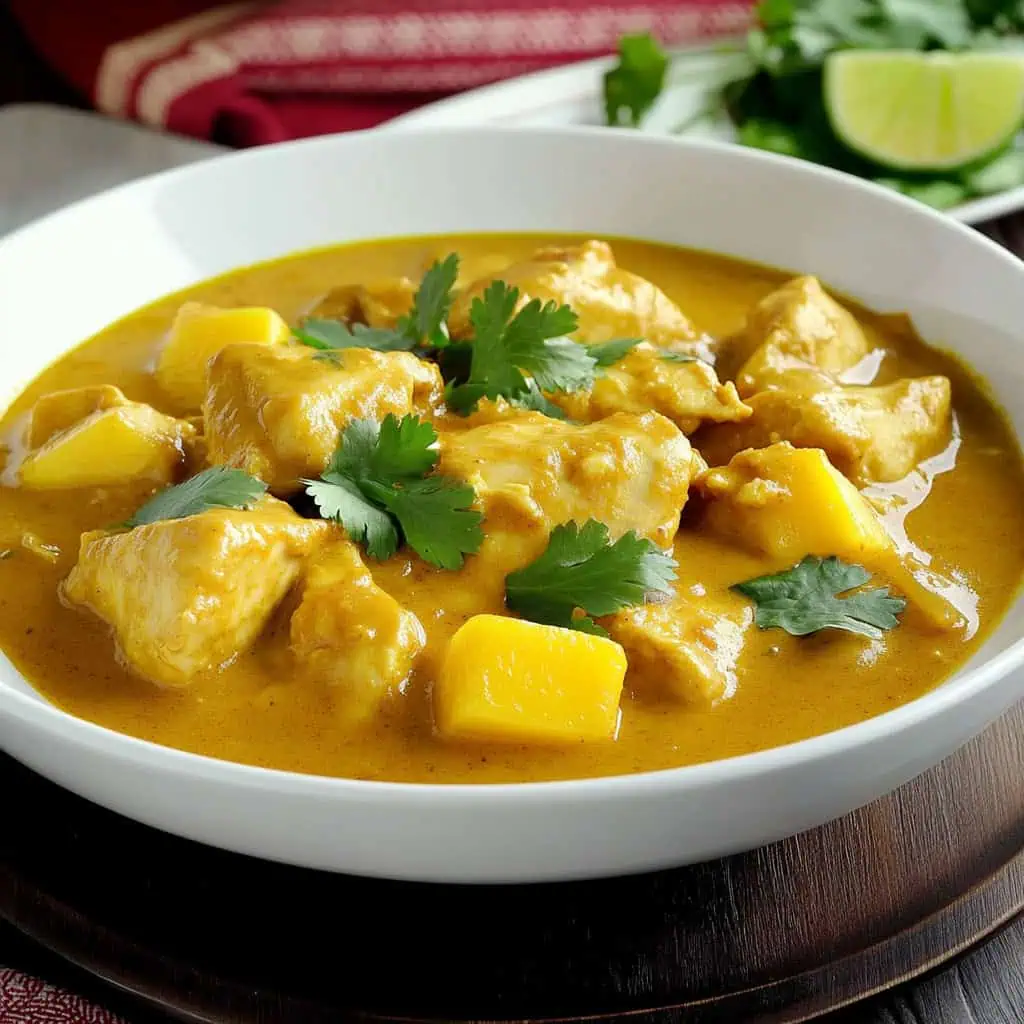
Why You'll Love This Recipe
- Perfect balance of sweet, savory, and curry flavors
- Uses fresh Philippine mangoes (manggang kalabaw)
- One-pan cooking for easy cleanup
- Ready in 30 minutes
- Restaurant-quality dish at home
- Budget-friendly yet impressive enough for special occasions
Ingredients
Each ingredient in this recipe serves a specific purpose in creating a harmonious dish. The sweet carabao mangoes balance the warm curry spices, while coconut milk provides a creamy base that binds everything together.
Chicken breast offers a neutral protein that absorbs flavors beautifully. The aromatic trio of onion, garlic, and ginger creates a fragrant foundation, while fish sauce adds that essential umami depth that can't be achieved with salt alone. The fresh herb garnishes brighten the rich curry and add visual appeal.
This thoughtful combination creates a perfect balance of sweet, savory, creamy, and aromatic elements that make this dish extraordinary.
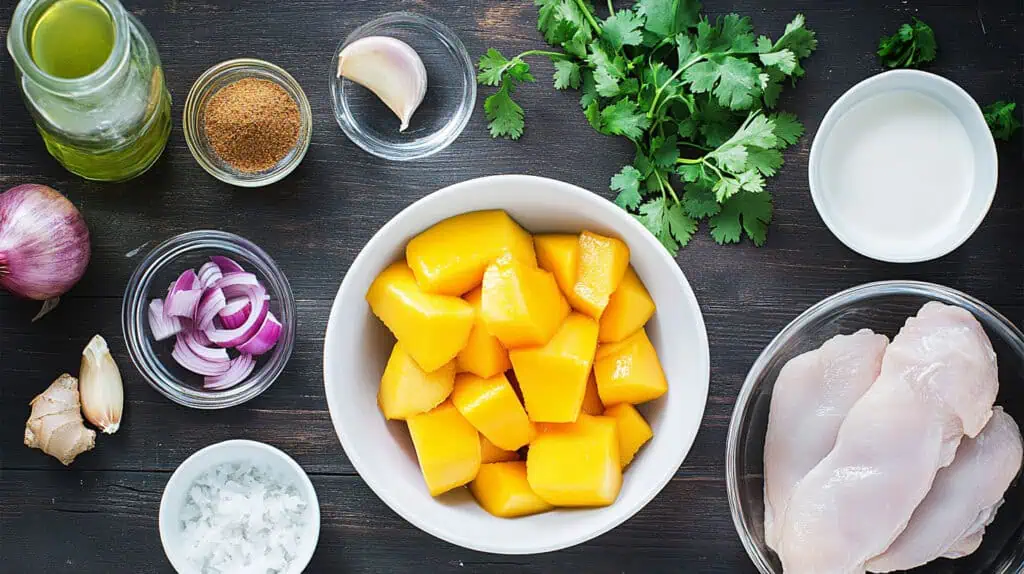
- 2 pounds boneless skinless chicken breast, cut into 1½-inch cubes
- 2 ripe Philippine mangoes (carabao mangoes), peeled and chunked
- 1 can (13.5 oz) coconut milk
- 2 tablespoons yellow curry powder, divided
- 1 tablespoon fish sauce
- 1 tablespoon canola oil
- 1 small onion, finely chopped
- 2 cloves garlic, minced
- 1 thumb-size ginger, minced
- Salt and freshly ground black pepper to taste
- Fresh cilantro leaves, for garnish
- Green onions, sliced, for garnish
Equipment
- Large, deep skillet or kawali: Provides even heat distribution and enough space for sauce reduction without spillover. The traditional Filipino kawali works perfectly for this dish with its curved sides that prevent splashing when stirring.
- Sharp chef's knife: Essential for cleanly cutting chicken and mangoes without crushing or tearing the flesh. A sharp knife ensures precise cuts that cook evenly.
- Wooden spoon or heat-resistant silicone spatula: For stirring without scratching your cookware and gently pressing mangoes to release their juices.
- Measuring spoons and cups: For accurate ingredient portioning, ensuring the perfect balance of flavors.
- Cutting board: Preferably use separate boards for meat and produce to prevent cross-contamination.
- Food thermometer: Optional but recommended to ensure chicken reaches the safe internal temperature of 165°F (74°C).
- Garlic press: Optional but helpful for mincing garlic quickly and evenly.
- Grater: For easily mincing ginger with maximum flavor extraction.
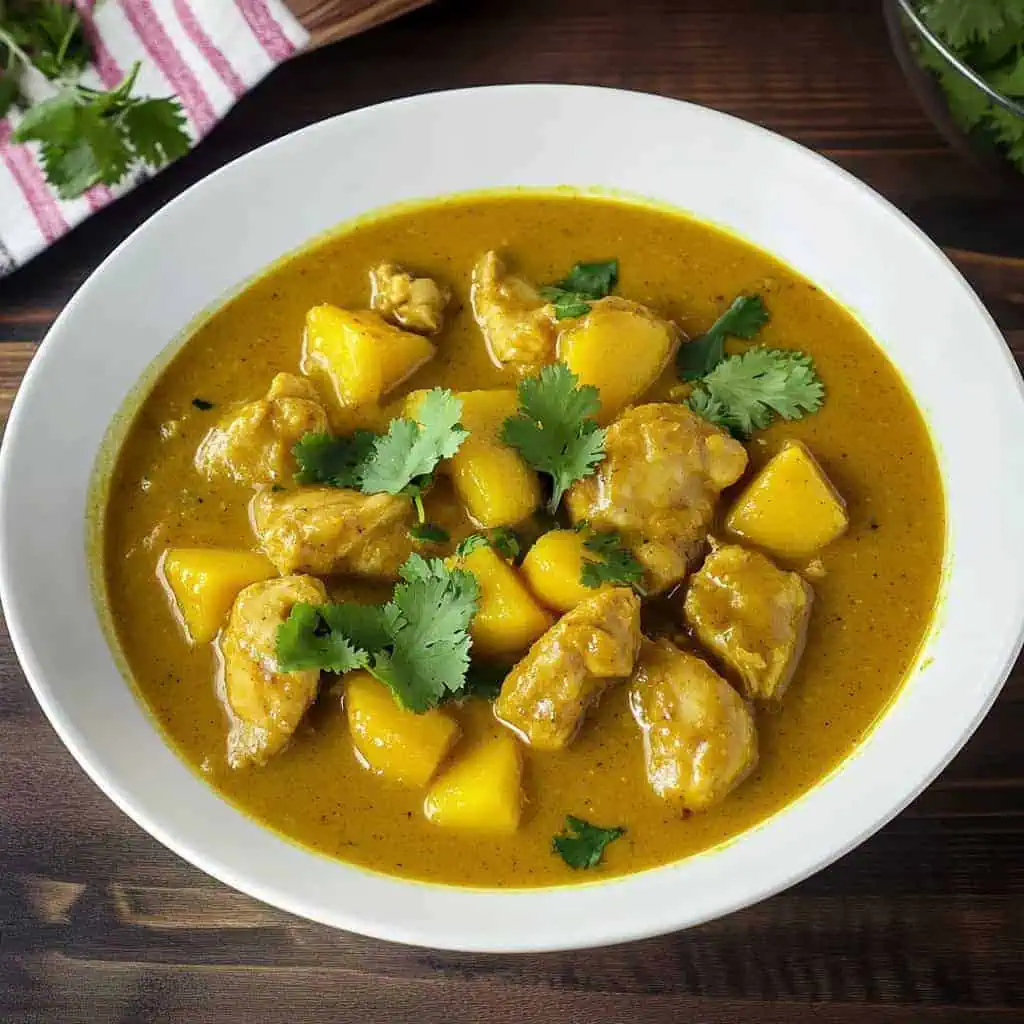
How To Make
- Marinate the chicken: Place chicken cubes in a bowl and mix thoroughly with 1 tablespoon curry powder, ½ teaspoon salt, and ¼ teaspoon black pepper. Allow to marinate for 30 minutes at room temperature while you prepare other ingredients.
- Prepare the aromatics and mangoes: Finely chop the onion, mince the garlic and ginger, and prepare your mangoes by peeling them and cutting into 1-inch chunks. Keep these ingredients separate as you'll add them at different cooking stages.
- Sauté the aromatics: Heat canola oil in a large, deep skillet over medium heat. Once hot, add chopped onions and cook until translucent and soft, about 2-3 minutes. Add minced garlic and ginger, cooking for another minute until fragrant.
- Cook the chicken: Add marinated chicken to the pan, spreading pieces evenly to ensure proper browning. Cook until light golden on all sides, approximately 5-7 minutes, stirring occasionally.
- Add seasonings: Pour in fish sauce and sprinkle the remaining tablespoon of curry powder over the chicken, stirring to coat evenly.
- Simmer in coconut milk: Pour in coconut milk and stir gently to combine. Reduce heat to low-medium, cover the pan, and simmer for 10-15 minutes until chicken is completely cooked through (internal temperature of 165°F/74°C).
- Incorporate mangoes: Add mango chunks to the pan. Using the back of your spoon, gently press some mango pieces to release their juice into the sauce. Continue cooking uncovered for 2-3 minutes until sauce slightly thickens. Taste and adjust seasoning with salt and pepper if needed.
- Rest and serve: Remove from heat and let rest for 2-3 minutes to allow flavors to meld. Transfer to a serving dish, garnish with fresh cilantro leaves and sliced green onions. Serve immediately with steamed jasmine rice.

Tips from Lola's Kitchen
- Mango selection is crucial: Choose mangoes that are ripe but still slightly firm. They should yield slightly to gentle pressure and have a sweet aroma near the stem. Too soft and they'll dissolve completely in your curry; too firm and they won't release enough sweetness.
- Layering flavors: Always cook your aromatics (onion, garlic, ginger) thoroughly before adding chicken. This builds a proper flavor foundation for the entire dish.
- The coconut milk secret: For extra richness, refrigerate your coconut milk overnight and skim the thick cream from the top to add during the final minutes of cooking. This creates an exceptionally creamy texture.
- Perfect marination: Don't skip the marination step! Even 15 minutes is better than none if you're short on time. The curry powder needs time to penetrate the chicken.
- Sauce consistency mastery: The ideal sauce should coat the back of a spoon but still flow slowly when tilted. If using an instant-read thermometer for chicken, take the opportunity to check sauce consistency too.
- Rice preparation timing: Start cooking your rice before beginning the curry so everything finishes at the same time. Nothing complements this dish better than freshly steamed jasmine rice.
Substitutions
- Protein alternatives: Boneless chicken thighs make an excellent substitute for chicken breast, offering more moisture and flavor. For a more economical option, use a whole cut-up chicken with bones (adjust cooking time accordingly).
- Mango options: When Philippine mangoes aren't available, substitute with Ataulfo (champagne) mangoes or Kent mangoes. In a pinch, canned mango pulp (about 1 cup) works, but add it during the last 5 minutes of cooking.
- Coconut milk substitutes: For a lighter version, use light coconut milk or a combination of ½ cup heavy cream mixed with ½ cup chicken broth and ½ teaspoon sugar.
- Curry alternatives: If you don't have curry powder, create your own blend with 1 teaspoon each of ground turmeric, ground coriander, and ground cumin, plus ¼ teaspoon each of ground ginger and ground cardamom.
- Fish sauce replacement: Substitute with 1 tablespoon soy sauce mixed with ¼ teaspoon sugar, or 1½ teaspoons Worcestershire sauce plus ½ teaspoon salt.
Troubleshooting
- Sauce is too thin: Simmer uncovered on low heat for 5-7 additional minutes to reduce. Alternatively, mix 1 teaspoon cornstarch with 1 tablespoon cold water and gradually stir into simmering curry until desired thickness is achieved.
- Sauce is too thick: Add warm chicken broth or water, 2 tablespoons at a time, until reaching desired consistency. Remember that the sauce will thicken slightly upon standing.
- Curry is separating or curdling: Immediately reduce heat to low. This typically happens when coconut milk boils too vigorously. Gently stir with a wooden spoon until re-emulsified. Prevention is key – never let your curry reach a rolling boil.
- Chicken is tough: This usually indicates overcooking. Next time, remove the chicken from heat when it reaches 160°F (71°C), as it will continue cooking to 165°F while resting. For the current batch, adding additional mango chunks can help mask the texture issue.
- Not enough mango flavor: Stir in 2 tablespoons mango nectar or 1 tablespoon mango jam during the final 2 minutes of cooking to boost the fruity notes.
- Too sweet: Balance with ½ to 1 teaspoon lime juice and an additional pinch of salt to restore equilibrium.
Storage & Reheating
- Refrigeration: Cool completely before transferring to an airtight container. Refrigerate for up to 3 days. The flavors actually improve overnight as they meld together.
- Freezing considerations: While possible, freezing is not recommended as the texture of the coconut sauce may change upon thawing, and mangoes can become mushy. If you must freeze, do so without the mangoes and add fresh ones when reheating.
- Stovetop reheating: For best results, reheat gently in a covered pan over low heat, adding 1-2 tablespoons of coconut milk or water to revitalize the sauce. Stir occasionally until reaching 165°F (74°C) internal temperature, about 5-7 minutes.
- Microwave reheating: Place in a microwave-safe container, add 1 tablespoon of water or coconut milk, cover loosely, and heat at 50% power in 1-minute intervals, stirring between each until thoroughly heated.
- Serving after storage: Refresh the dish with a sprinkle of freshly chopped cilantro and a squeeze of lime juice just before serving reheated curry.

FAQ
Can I use green mangoes instead of ripe ones?
No, green mangoes would create an entirely different dish with sour notes rather than the sweet balance needed for this curry. Ripe mangoes are essential for the intended flavor profile.
How spicy is this curry?
As written, this recipe creates a mild to medium spice level, depending on your curry powder brand. For a spicier version, add 1-2 finely chopped bird's eye chilies (siling labuyo) with the aromatics. For a milder version, use a mild curry powder and add a tablespoon of plain yogurt to temper the heat.
Can I make this dish in advance for a party?
Yes, but with some adjustments. Prepare the curry without mangoes up to one day ahead, then reheat gently and add fresh mangoes during the final 5 minutes of reheating. This preserves the mango texture and freshness.
Why did my coconut milk curdle?
High heat is typically the culprit. Always simmer coconut milk-based curries on low to medium-low heat and avoid boiling. If using light coconut milk or low-fat versions, they're more prone to separation.
Can I add vegetables to this curry?
Absolutely! Bell peppers, snow peas, or baby spinach make excellent additions. Add heartier vegetables like bell peppers with the chicken and quick-cooking vegetables like spinach during the last 2 minutes of cooking.
Is this recipe gluten-free?
Yes, but always check your curry powder and fish sauce labels to ensure they're gluten-free, as some brands may contain additives with gluten.
How do I adjust this recipe for a larger crowd?
The recipe doubles easily – use a larger pot and increase cooking time by about 5 minutes. For best results when cooking for more than 8 people, consider making multiple batches rather than one very large one to maintain proper sauce consistency.
Related
Looking for other recipes like this? Try these:
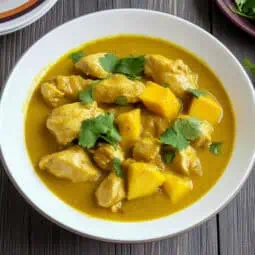
Filipino Mango Curry Chicken (Manok sa Gata at Mangga)
Equipment
- Large, deep skillet or kawali (for even heat distribution and sauce reduction)
- Sharp knife (for cutting chicken and mangoes)
- Wooden spoon or spatula (panghalukay - for stirring without scratching the pan)
- Measuring spoons and cups (panukat)
- Cutting board (Sangkalan)
- Food thermometer (optional, but recommended for perfectly cooked chicken)
Ingredients
Main Ingredients:
- 2 pounds boneless skinless chicken breast (pinaghiwalay na dibdib ng manok)
- 2 ripe Philippine mangoes hinog na manggang kalabaw
- 1 can 13.5 oz coconut milk (gata)
- 2 tablespoons yellow curry powder pulbos na curry
- 1 tablespoon fish sauce patis
- 1 tablespoon canola oil langis
Aromatics:
- 1 small onion chopped (sibuyas)
- 2 cloves garlic minced (bawang)
- 1 thumb-size ginger minced (luya)
For Garnish:
- Fresh cilantro leaves wansuy
- Green onions dahon ng sibuyas
Instructions
- Start by cutting your chicken breasts into even 1½-inch cubes - they should all be about the same size so they cook evenly. Place these cubes in a bowl and mix well with 1 tablespoon curry powder, salt, and pepper. Let this sit for 30 minutes to absorb the flavors while you prepare everything else.
- During this time, chop your onion into small pieces, mince your garlic and ginger, and prepare your mangoes by peeling them and cutting into chunks. Keep these all separate as you'll add them at different times.
- Heat your canola oil in a large, deep pan over medium heat. Once the oil is hot, add your chopped onions and cook them until they turn clear and soft, about 2-3 minutes. Add your minced garlic and ginger and cook for another minute until you can really smell their aroma.
- Now add your marinated chicken to the pan, spreading it out so all pieces can brown nicely. Let it cook until it turns light golden, about 5-7 minutes. Pour in your fish sauce and the remaining curry powder, stirring to coat all the chicken pieces evenly.
- Pour in your coconut milk and stir everything together gently. Lower the heat, cover the pan, and let it simmer slowly for 10-15 minutes. The chicken should be completely cooked through - cut into a piece to check if you're unsure.
- Add your mango chunks to the pan. Using your spoon, gently press some of the mango pieces to release their juice into the sauce. Let this cook uncovered for 2-3 minutes until your sauce thickens slightly. Taste it and add more salt or pepper if needed.
- Take the pan off the heat and let it rest for 2 minutes - this helps all the flavors come together nicely. Transfer everything to a serving bowl, sprinkle with fresh cilantro and green onions if you like, and serve hot with plenty of rice.
- Remember to serve this right away while the sauce is still creamy and the mangoes are warm but haven't completely dissolved into the sauce. The curry should be rich and creamy with a perfect balance of sweet from the mangoes and savory from the curry and chicken.
Tips from Lola's Kitchen
- Choose mangoes that are ripe but still firm (hindi sobrang lambot)
- For extra richness, use first-press coconut milk (kakang gata)
- Don't rush the sauce reduction - slow cooking develops better flavors
- If sauce is too thick, add warm water gradually
- Always taste before adding salt, as fish sauce is already salty
Nutrition
The Story Behind Filipino Mango Curry Chicken
Growing up in a Filipino household, I've always been fascinated by how we've embraced and transformed curry into our own. While traditional chicken curry has become a beloved fixture in Filipino homes, I discovered this unique twist during one particularly abundant mango season in our province. Our kitchen counter was overflowing with ripe carabao mangoes – that distinctly sweet Philippine variety that's famous worldwide – when inspiration struck.
Curry itself has an interesting journey in Filipino cuisine, arriving through various cultural influences, from Indian traders to Southeast Asian neighbors. We've made it our own by incorporating coconut milk (gata), a staple in Filipino cooking. This mango version, however, represents a modern evolution of our love affair with curry, showcasing how Filipino cooks continue to innovate with local ingredients.
The combination might seem unusual at first, but it actually draws from Southeast Asian culinary traditions where fruit in savory dishes is common – think Thai mango curry or Indonesian curries with pineapple. What makes this version distinctly Filipino is the use of our prized carabao mangoes, known for their exceptional sweetness and smooth, fiber-free flesh. Combined with creamy coconut milk and aromatic curry powder, it creates a sauce that's simultaneously exotic and comfortingly familiar.
This recipe has become increasingly popular in modern Filipino home kitchens, especially during mango season when we're looking for creative ways to use our abundance of fruit. It's a perfect example of Filipino food innovation – taking familiar ingredients and combining them in new ways while staying true to our love of balanced sweet-savory flavors. Whether served at family Sunday lunches or special gatherings, this dish never fails to spark conversations and recipe requests.
What started as a creative solution to a mango surplus has evolved into a contemporary Filipino dish that honors both our local ingredients and our openness to global flavors. It's a testament to how Filipino cuisine continues to evolve while maintaining its distinct identity – something we see in many modern Filipino kitchens today, where tradition meets innovation over a steaming pot of rice.
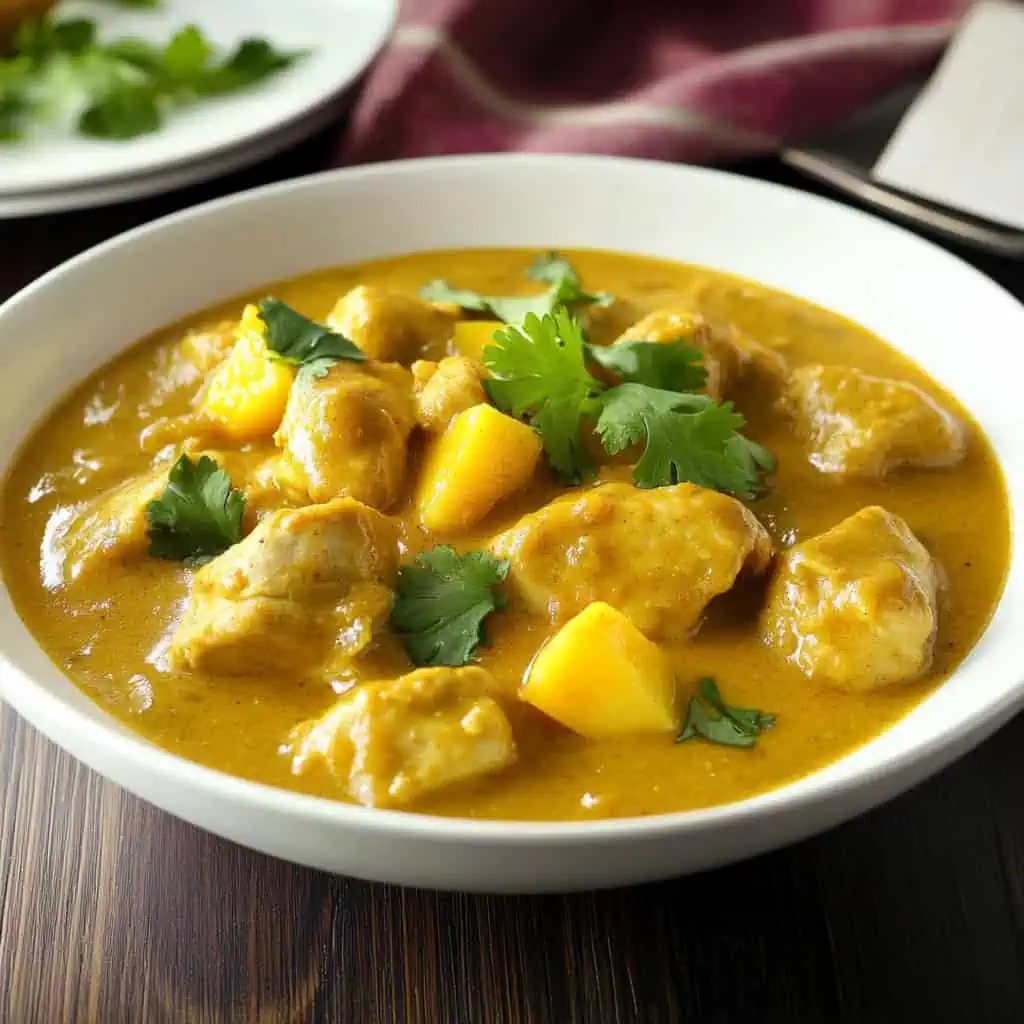









Comments
No Comments